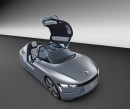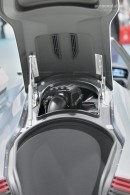Just as we told you, the German carmaker Volkswagen was planning to debut the 1-liter concept vehicle at the Frankfurt Auto Show, a car often described as "the most fuel-efficient automobile in the world". The "second-generation" of the L1 is powered by the smallest diesel engine intended for production and manufactured by Volkswagen - a 0.8-liter TDI unit that burns only 1.38 liter of diesel per 100 kilometers (170 mpg).
The 800 cmc TDI unit develops a power of 20 kW / 27 PS (at 4,000 rpm) while in sport mode the maximum output rises to 29 kW / 39 PS (at 4,000 rpm). The maximum torque is 100 Nm at 1,900 rpm. According to Volkswagen, the 0.8 unit is derived from the 1.6 TDI option rolled out a few months ago and available on the Golf BlueMotion and Passat BlueMotion.
In order to achieve the best fuel efficiency figures, the engine is connected to a 7-speed DSG, with the car also featuring a Stop-Start system that automatically idles the engine when the car is not in motion.
The L1 comes with no exterior rear-view mirrors as the German brand installed OLD-active displays connected to cameras providing images to the driver. A Park Distance Control system is also available for parking assistance. Both the headlights and the taillights are using LED technology, thus reducing the energy consumption.
The car is offered with Michelin low-resistance tires: front 95/60 R16 and rear 115/70 R16.
"The design of the L1 redefines classic and aesthetic vehicle traits. Especially significant, of course, is how the nearly rocket-shaped lines catch one's attention. All of its moving parts are integrated so accurately that the body resembles a rocket or jet. It is a body that cuts through the air with minimal aerodynamic resistance," Walter de Silva, Head of Design for the Volkswagen Group, said.
The 800 cmc TDI unit develops a power of 20 kW / 27 PS (at 4,000 rpm) while in sport mode the maximum output rises to 29 kW / 39 PS (at 4,000 rpm). The maximum torque is 100 Nm at 1,900 rpm. According to Volkswagen, the 0.8 unit is derived from the 1.6 TDI option rolled out a few months ago and available on the Golf BlueMotion and Passat BlueMotion.
In order to achieve the best fuel efficiency figures, the engine is connected to a 7-speed DSG, with the car also featuring a Stop-Start system that automatically idles the engine when the car is not in motion.
The L1 comes with no exterior rear-view mirrors as the German brand installed OLD-active displays connected to cameras providing images to the driver. A Park Distance Control system is also available for parking assistance. Both the headlights and the taillights are using LED technology, thus reducing the energy consumption.
The car is offered with Michelin low-resistance tires: front 95/60 R16 and rear 115/70 R16.
"The design of the L1 redefines classic and aesthetic vehicle traits. Especially significant, of course, is how the nearly rocket-shaped lines catch one's attention. All of its moving parts are integrated so accurately that the body resembles a rocket or jet. It is a body that cuts through the air with minimal aerodynamic resistance," Walter de Silva, Head of Design for the Volkswagen Group, said.


























